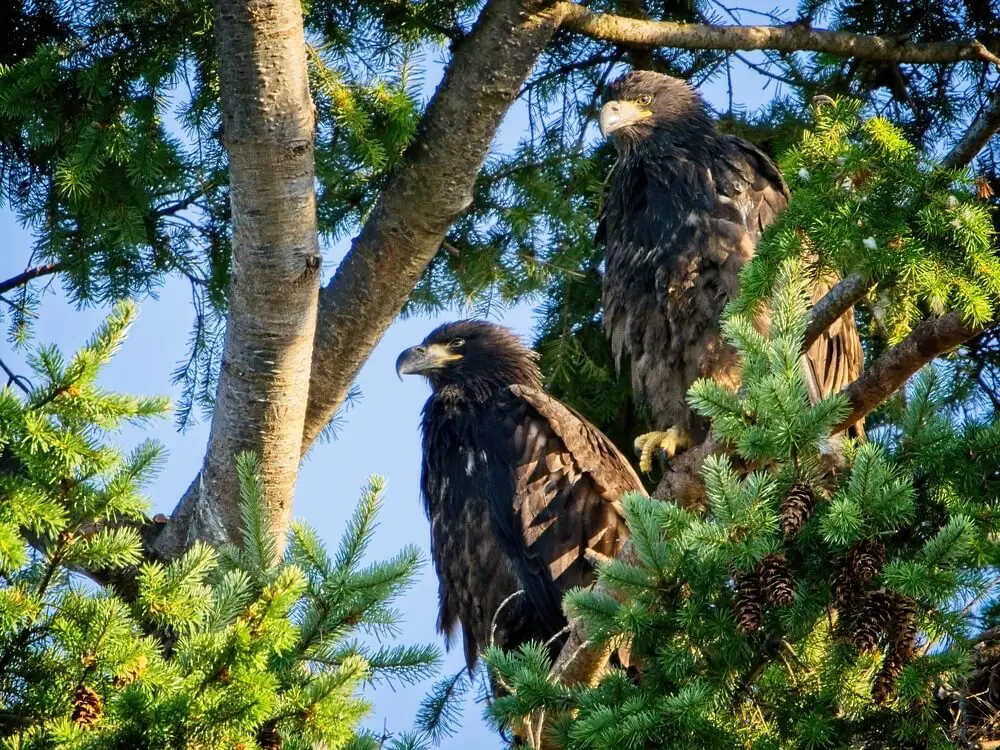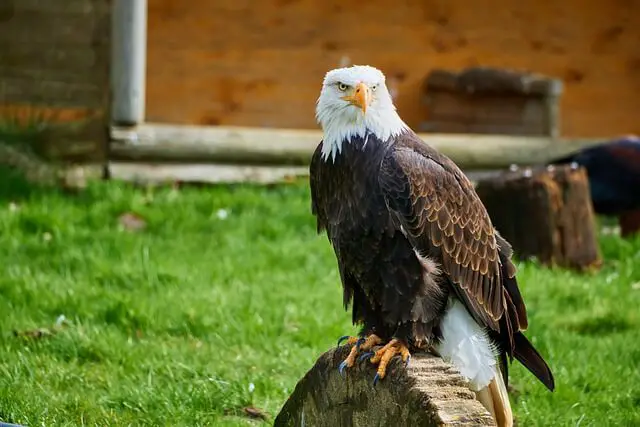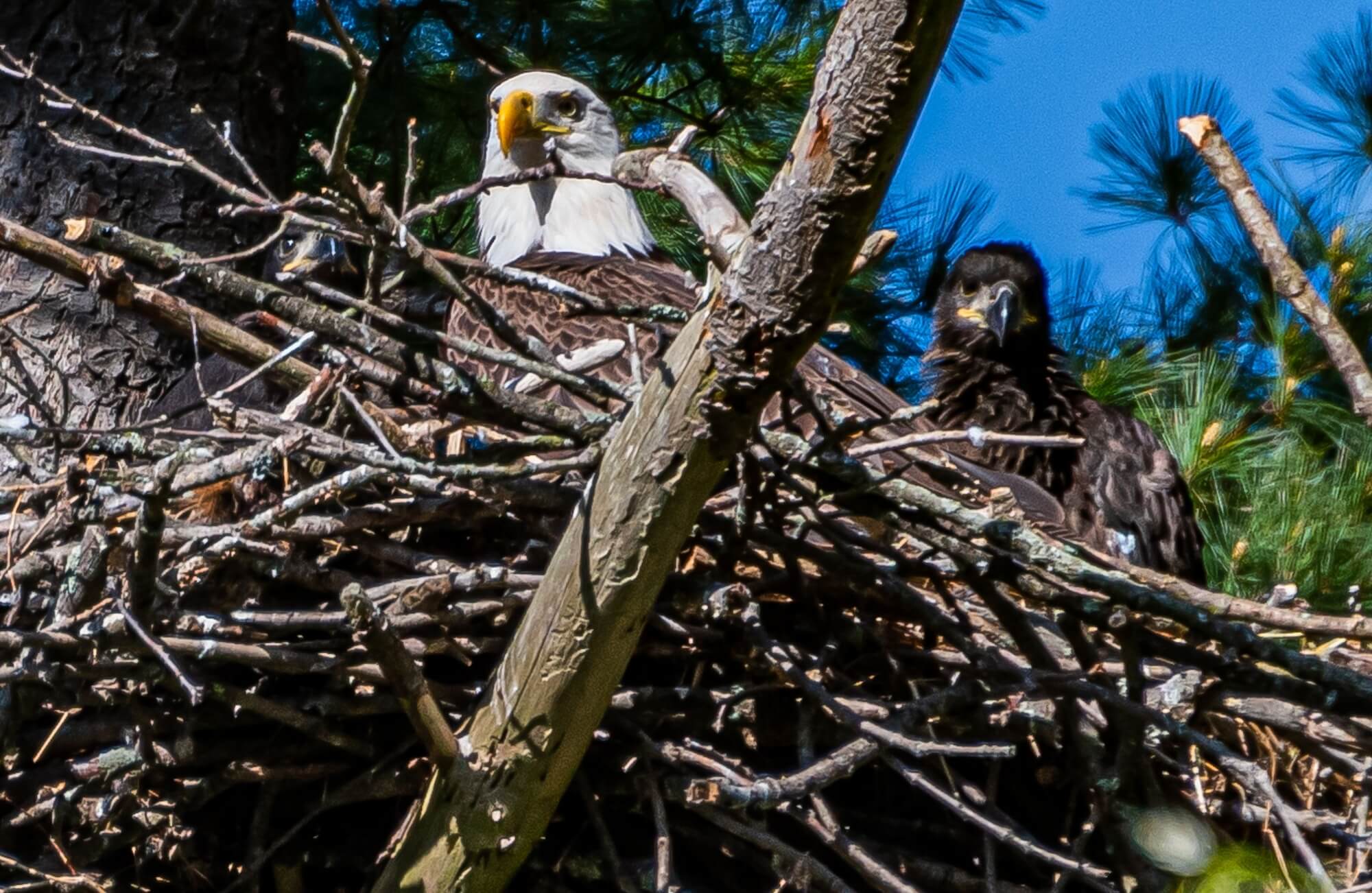If you’ve never seen a Bald Eagle in person, then you are doing yourself a disservice. These are birds that will get your heart beating and make you want to go home and write something truly inspiring. The real inspiration, however, starts by answering the question ‘how long do Bald Eagles stay with their parents?’.
Today I’ll answer this question in a little more detail and paint you a picture of an Eaglet’s life, from ‘conception to cap.’ If you find their looks inspiring, then just wait until you get a taste of their lives. I’ll give you a hint – it’s not easy being an apex predator, and only the fiercest may apply!
Here’s How Long Bald Eagles Stay With Their Parents:
Bald Eagle chicks will stick around the nest for approximately 4 to 5 weeks, though they technically leave it between 10 and 12 weeks of age. It’s an uphill battle, too, with only half of the chicks being likely to ever taste the wind outside on their own.

While Bald Eagle chicks leave after approximately 12 weeks, statistics tell us that Florida Bald Eagles are actually the ‘early birds,’ choosing to leave at 11 weeks to get a ‘head start’ at adulthood. Now, while they do leave home, that doesn’t mean that they won’t be nearby. These birds make for closer families then most.
As such, though these little Eaglets have technically left the nest, they are often found nearby quite frequently, for as much as 4 to 5 weeks after leaving the nest proper. During this time, they are practicing their flight but keeping close to home, and they are blessed to have supportive parents throughout this important phase of their lives.
While the little ones are racking up their hours of flight experience and learning to hunt snacks on their own, Mom and Dad are still helping out by feeding their fledglings from time to time. It’s rather like with humans, where mom and dad are sending care packages as their children adjust to college life.
After around 5 weeks, however, most of the Eaglets will be ready to make their own way, and the parents can relax with their job well-done.
Leaving the nest is only the ‘climax’ portion of the story, however, so let’s take a look at what comes before to paint you a bigger, better picture of the Eagle family experience.
A romantic start — but homebuilding seals the deal
When it comes to courtship, Hollywood Rom-coms have got nothing on Eagles – these birds really bring the romance. While scientists still don’t know exactly what the Eagles are looking for in each other, their ‘mating dance’ in the skies shows us that they are quite serious about selection – and well, they should be!
Bald Eagles mate for life.
Meeting in the sky, these majestic birds circle and soar until finally locking talons and diving together in a dizzying spiral that makes your heart skip a beat. At the last minute, the ‘cartwheel courtship flight’ is concluded by the Eagles breaking apart, and they will either separate or fly off happily together to start their new lives.
As dramatic as their courtship might be, this by no means seals the deal, as what really brings the couple together is the building of their nest.
While an abandoned nest might be used, more often, a new one is built altogether, and the pair take turns building their family home in shifts – one building, one keeping watch.
If there are signs of humans or other perceived predators too close to the nest site, then the Eagles will abandon it to start one somewhere else.
Otherwise, within a few days, the nest is complete, and working together has been enough of a bonding experience that the female is ready to breed. In just two days, there will be eggs!
While watching a bald eagle, have you ever got confused to differentiate between a male or female? Did you wonder if the females have white heads or not? Then I highly suggest you to read my guide: Do Female Bald Eagles Have White Heads? (5 Key Differences!)
Caring of the eggs and feeding
Eagles put a lot of care into raising their families, and before those eggs are laid, the nest has been optimized for them.
Eagles take corn husks and grass, which they will shred and use to create ‘egg cups’ that will serve to effectively keep weather-woes such as ice, water, and snow at bay.
Eagles make a concerted effort when it comes to their young, who won’t hatch for another 35 days.
Both the male and the female will take turns sitting on the eggs, but for the largest part, the male will do most of the hunting, feeding the new mother and giving her a little well-deserved rest.
Once the chicks discover that they have an ‘egg tooth’ that can make short of their shells, then the young ones get their first taste of daylight and the fresh air — and these littles are quite hungry.
It’s notable that the chicks won’t be eating a ‘secondhand-meal.’
Eagles don’t regurgitate food and give it to their young, but rather start these apex predators off the right way with every meal consisting of freshly-killed meat. Still the gentleman, the male will do most of the hunting for about 3 weeks, and after that, they take turns.
A 50/50 chance to live
Despite all of the love and care that mom and dad provide, young Eaglets only have about a 50/50 chance at survival.
It’s a harsh reality, but such is the life of the raptor, and it’s not uncommon for a dominant Eaglet to make a meal of a brother or sister who was not fierce enough to ‘make the cut.’
While this mostly happens when there is not enough food to go around, it does occur, and this is not the only danger of growing up in such an otherwise loving nest. While the adult Bald Eagle has no natural predators, the young haven’t earned that privilege yet. Salivating nearby is a danger:
- Bobcats
- Foxes
- Other birds (such as the Great Horned Owl)
- Raccoons
- Wolverines
As you can see, it’s not easy being an Eaglet, and Nature does its best to make these little guys and gals tough, throwing storms into the equation which can launch the little ones fatally from the nest in a heartbeat. Even so, half of the chicks will typically survive, and at 4 weeks, they get their pin feathers.
The pin feathers appear at the edges of their wings and atop the Eaglet’s heads, and during this time, they will ‘branch’ before they fully fledge.
Holding their wings aloft, the young Eaglets get a feel for the drafts of the mighty wind before they go to take their first ride.
Learning to fly
By 10 to 12 weeks, the chicks have built up their courage sufficiently to take their first plunge, and their bodies are ready for it. It’s been an interesting and educational time, after all.

The Eaglets have been watching their parents closely and testing the drafts carefully with their own wings – often ‘levitating’ slightly above the nest as they learn the rules of the wind. Despite what you may have heard, the Eaglet’s Mom and Dad don’t push their young out of the nest – but rather, they taunt them.
As the young ones learn about flight by observing the parents and their little levitations, the parents are taking note of this, and when they think their young are ready, then they will encourage the Eaglets with taunts and a challenge. They do this by moving the food.
When coming home from a successful hunt, mom and dad will now perch just out of reach, and happily much on what they’ve caught while vocalizing encouragements and sometimes even taunts! Eventually, this has the intended effect, and the hungry Eaglets will take that first fateful flight.
Earning their white cap
For the next 4 to 5 weeks, the newly airborne Eaglets will slowly increase their hunting range, coming back for shared meals with their parents before finally going off on their own.
While the young will leave, Mom and Dad are going to keep and even continue building up their love-nest, with some Bald Eagle couples using the same nest that they’ve built together for up to 35 years, though often they will build a few extra nests close by for a little variety as they return to nest each year.
The young Eaglets will go on to find their own way and to eventually take a mate of their own, but they won’t yet have that ‘distinctive’ full-plumage that we’ve come to expect from the majestic Bald Eagle.
Despite all their hard work, they won’t get their full ‘white cap’ until they’ve reached about 5 ½ years of age, with the exception of approximately 25% of the new Eaglets. Those lucky birds might get their plumage upgrade sooner — as early as 4 ½ years into their new lives!

Some closing words
So, today we’ve taken a closer look at family life in a Bald Eagle nest. The next time that you are fortunate enough to see one of these apex predators, I hope that you’ll take a moment to appreciate what it took for them to get where they are today.
With storms, hungry raccoons, and even hungry siblings to watch out for, only half of the Eaglets that escaped their eggs will make it, but the bright side of this is that the animal kingdom seems to be quite aware of this fact.
Nothing hunts adult Bald Eagles because their parents raised them RIGHT!
You May Also Like To Check Out:


